Use the options on the Details tab to determine constructional details of handrails and posts
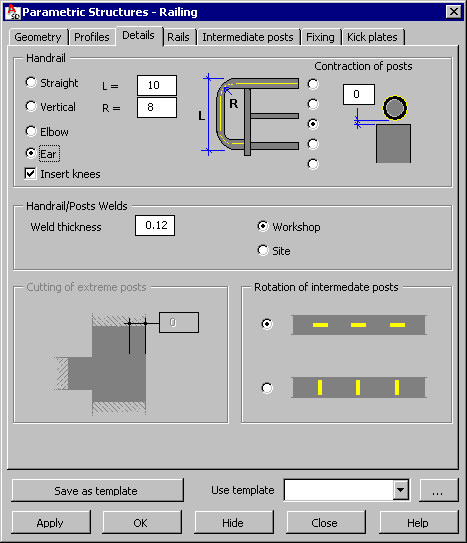
In the upper part of the dialog, select the geometry type for the railing handrail. The handrail is a continuous profile over the whole polyline length. Posts are trimmed and welded to the handrail using the workshop or site fillet welds of thickness that you specify under Handrail/Posts Welds.
If the handrail is made of an angle, the handrail position with respect to the post is as displayed below. If the handrail is made of a flat profile, it is positioned horizontally. For other profile types, the handrail is set in such a way that the axis of the greater moment of inertia is perpendicular to the railing plane. The handrail is treated exactly as rails (middle and lower ones) defined in the railing.
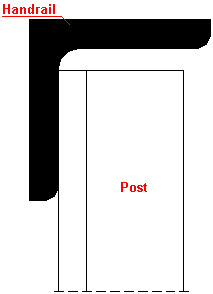
Available handrail types:
- Straight
 - a handrail is cut by a vertical plane at the beginning and at the end of a railing
- a handrail is cut by a vertical plane at the beginning and at the end of a railing - Vertical
 - at the beginning and at the end of a railing, a handrail ends with a vertical segment made of the same profile as the entire handrail. The handrail and the vertical segment are trimmed in such a way that the cutting plane bisects the angle between the handrail and the vertical ending of the railing. The railing's vertical ending is welded to the railing by means of the workshop weld with a thickness that is equal to the thickness of walls in the railing profiles. For this type of handrail end, the length of the vertical handrail part L is defined.
- at the beginning and at the end of a railing, a handrail ends with a vertical segment made of the same profile as the entire handrail. The handrail and the vertical segment are trimmed in such a way that the cutting plane bisects the angle between the handrail and the vertical ending of the railing. The railing's vertical ending is welded to the railing by means of the workshop weld with a thickness that is equal to the thickness of walls in the railing profiles. For this type of handrail end, the length of the vertical handrail part L is defined. - Elbow
 - at the beginning and at the end of a railing, a handrail ends with a bent part. The bent part may be a segment made of the same profile as the entire handrail (the Insert knees option not selected) or an additional knee made of the same profile as the handrail and welded to the handrail using the workshop weld with a thickness that is equal to the thickness of walls in the railing profiles (the Insert knees option selected). For this type of handrail end, the length of vertical handrail part L and radius of handrail bend R are defined.
- at the beginning and at the end of a railing, a handrail ends with a bent part. The bent part may be a segment made of the same profile as the entire handrail (the Insert knees option not selected) or an additional knee made of the same profile as the handrail and welded to the handrail using the workshop weld with a thickness that is equal to the thickness of walls in the railing profiles (the Insert knees option selected). For this type of handrail end, the length of vertical handrail part L and radius of handrail bend R are defined. - Ear
 - at the beginning and at the end of a railing, a handrail ends with two bent parts. The bent parts may be segments made of the same profile as the entire handrail (the Insert knees option not selected) or the additional knees made of the same profile as the handrail and welded to the handrail using the workshop welds with a thickness that is equal to the thickness of walls in the railing profiles (the Insert knees option selected). For this type of handrail end, length of vertical handrail part L and radius of handrail bend R are defined.
- at the beginning and at the end of a railing, a handrail ends with two bent parts. The bent parts may be segments made of the same profile as the entire handrail (the Insert knees option not selected) or the additional knees made of the same profile as the handrail and welded to the handrail using the workshop welds with a thickness that is equal to the thickness of walls in the railing profiles (the Insert knees option selected). For this type of handrail end, length of vertical handrail part L and radius of handrail bend R are defined.
Available methods of post ending (connection with the handrail):
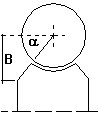 - post profiles are trimmed in such a way that the post ending fits the handrail shape. The post is cut symmetrically on the sides (the cutting planes are determined by specifying a value of the Alpha angle that must be less than 90 degrees). Additionally, the dimension B has to be given.
- post profiles are trimmed in such a way that the post ending fits the handrail shape. The post is cut symmetrically on the sides (the cutting planes are determined by specifying a value of the Alpha angle that must be less than 90 degrees). Additionally, the dimension B has to be given. 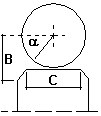 - post profiles are trimmed in such a way that the top surface of a post is trimmed with a horizontal plane below the handrail. The post is cut symmetrically on the sides (the cutting planes are determined by specifying a value of the Alpha angle that must be less than 90 degrees). Additionally, the dimensions B and C have to be given.
- post profiles are trimmed in such a way that the top surface of a post is trimmed with a horizontal plane below the handrail. The post is cut symmetrically on the sides (the cutting planes are determined by specifying a value of the Alpha angle that must be less than 90 degrees). Additionally, the dimensions B and C have to be given. 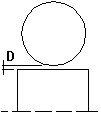 - post profiles are trimmed with a vertical plane. Additionally, the dimension D (a distance between the post and the handrail) has to be given.
- post profiles are trimmed with a vertical plane. Additionally, the dimension D (a distance between the post and the handrail) has to be given. 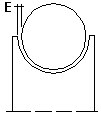 - post profiles are elongated to the level of the horizontal axis of the handrail, and then are fitted to the handrail shape. Additionally, the dimension E (a distance between the post and the handrail) has to be given.
- post profiles are elongated to the level of the horizontal axis of the handrail, and then are fitted to the handrail shape. Additionally, the dimension E (a distance between the post and the handrail) has to be given. 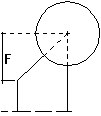 - post profiles are cut diagonally at the top, while one of the post sides is extended to the handrail axis. Additionally, the dimension F has to be given.
- post profiles are cut diagonally at the top, while one of the post sides is extended to the handrail axis. Additionally, the dimension F has to be given.
Define parameters in the lower part of the dialog:
- Cutting of extreme posts - the depth of cutting a post to fit the handrail of a railing
- Rotation of intermediate posts - the orientation of the cross-section of intermediate posts
![]() according to the orientation of main posts
according to the orientation of main posts
![]() perpendicular to the orientation of main posts
perpendicular to the orientation of main posts
After you define the constructional details of the handrail/posts, click the Rails tab to display the Railing - Rails dialog.